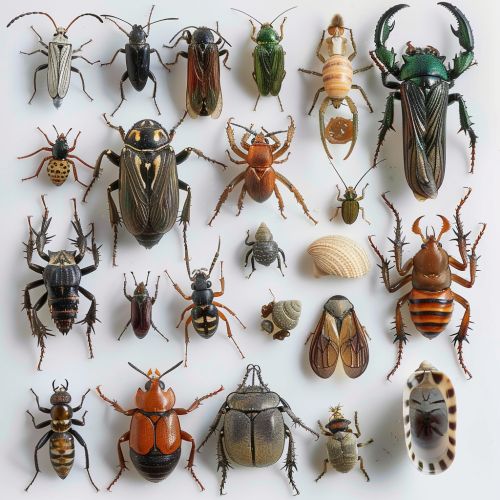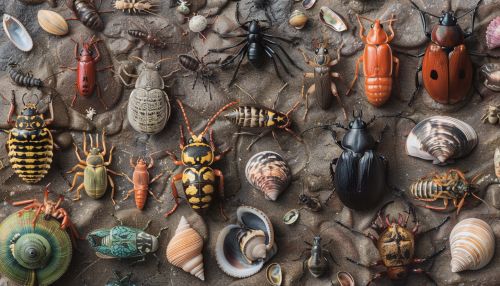Invertebrates
Overview
Invertebrates are animals that do not possess or develop a vertebral column (commonly known as a backbone or spine), derived from the notochord. This includes all animals apart from the subphylum Vertebrata. Invertebrates make up about 97% of all animal species on Earth, making them a significant portion of the world's biodiversity. They range in size from microscopic mites and almost invisible crustaceans to giant squid and spiders.


Classification
Invertebrates are classified into several main categories. These include the Porifera (sponges), Cnidaria (jellyfish, sea anemones), Platyhelminthes (flatworms), Nematoda (roundworms), Annelida (segmented worms), Mollusca (snails, clams, octopuses), Arthropoda (insects, spiders, crustaceans), Echinodermata (starfish, sea urchins), and others. Each of these groups has its unique characteristics and evolutionary history.
Anatomy and Physiology
The anatomy and physiology of invertebrates are as diverse as the species themselves. They may have a simple, unsegmented body, as in the case of sponges, or a complex, segmented body, as in the case of arthropods. Many invertebrates, such as insects and spiders, have an exoskeleton, a hard outer covering that provides support and protection. Others, like mollusks, have a soft body often protected by a hard shell.
Reproduction and Development
Invertebrates employ a wide range of reproductive strategies. Some reproduce asexually, through budding, fragmentation, or parthenogenesis, while others reproduce sexually. Many invertebrates, such as insects, undergo complex life cycles with distinct larval stages.
Ecology
Invertebrates play crucial roles in their ecosystems. They are often at the base of food chains, serving as a food source for larger animals. Many are decomposers, breaking down dead organic material and recycling nutrients back into the ecosystem. Others, like bees and butterflies, are important pollinators, helping in the reproduction of plants.
Evolution
Invertebrates are believed to have evolved from single-celled organisms. The first invertebrates, simple multicellular organisms, appeared in the oceans over 600 million years ago. Over time, they evolved into the diverse array of species we see today.
Human Interaction
Humans interact with invertebrates in a variety of ways. Many invertebrates, such as bees and silkworms, are beneficial to humans, providing honey, silk, and other products. Others, like mosquitoes and ticks, are vectors for diseases. Some invertebrates, such as certain species of jellyfish and spiders, can be harmful or even deadly to humans.
Conservation
Many invertebrate species are threatened by habitat loss, pollution, climate change, and other human activities. Conservation efforts for invertebrates often focus on protecting habitats and reducing threats. However, because of their vast numbers and diversity, invertebrates present unique challenges for conservation.
